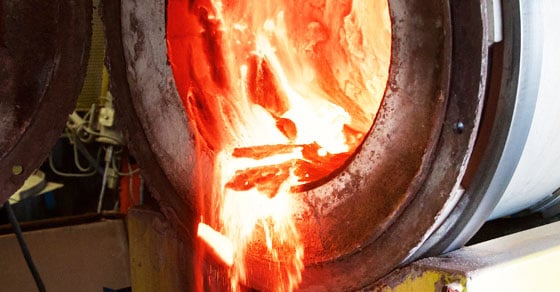A rotary kiln is a thermal processing tool used in a variety of applications. It consists of a rotating drum with high temperature products of combustion flowing through or around it, creating a precisely controlled environment for material property change.
Due to the substantially high internal temperatures of rotary kilns, observing a material’s phase change is difficult and sometimes impossible. This results in some misunderstanding of what’s happening inside the kiln, and the variety of applications a rotary kiln can be used for. If you think a rotary kiln may be the right piece of equipment for your thermal processing needs, then obtaining a good understanding of processes that are possible with a kiln is the first step in understanding its many uses.
Calcination
The calcination process requires heating a material to a high temperature with the intent of chemical dissociation (chemical separation). Calcination is commonly used in the creation of inorganic materials. One of the most common examples would be the dissociation of calcium carbonate to create calcium oxide and carbon dioxide.
The calcination process could also include the removal of bound moisture. An example of this process is the removal of moisture from a viscous sludge. Because a percentage of the moisture in the sludge is bound to the solids, a drying or pressing process would not effectively remove all of the moisture required to create a dry (ash) granule.
Thermal Desorption
Thermal desorption uses heat to drive off an organic chemical, such as a pesticide, that has mixed with an inorganic mineral like sand. It is important to remember that this is not incineration, which may produce harmful pollutants and would require a more extreme exhaust treatment system; instead it is a separation process that uses the different reaction temperatures of absorbent minerals and chemicals. The organic chemical (e.g. pesticide) becomes volatile at the increased temperature, causing a separation without combustion. In some cases, an indirect rotary kiln would be best for this application, because the volatile chemicals may be combustible. The indirect kiln will generate enough heat for desorption, without the material coming into direct contact with the flame.
Organic Combustion
Organic combustion is the thermal treatment process of organic waste. This combustion process leaves behind ash that has considerably less mass and volume. The most common use for this rotary kiln process would be in waste treatment plants with the intent of reducing the volume of waste for depositing in landfills. Direct-fired rotary kilns are the most common style for this application, because direct contact between the burner flame and the material is acceptable.
Sintering/Induration
Sintering is the process of heating the raw materials to a point just before melting. The objective of this process is to use the high internal temperature of the rotary kiln to increase the strength of the material. The most common use of this process is in the creation of manufactured proppants, where the sand or ceramic material needs to be structurally secure without increasing the mass.
Heat Setting
This is a process of bonding a heat resistant core mineral with another, less heat resistant coating material. Much like other coating processes, there is a core material and a coating material (usually mixed with a binding agent). The difference between this process and a non-heated coating process is that a rotary kiln heats the coating material to just below its liquefaction point. At this heated state, the material can coat the heat resistant core evenly and, since this is a chemical phase change, more securely than a traditional coating process. A common application of this process would be in the manufacturing of roofing granules, where a mineral such as granite is coated with a colored pigment, producing a durable and aesthetically pleasing granule.
Reduction Roasting
Reduction roasting is the removal of oxygen from a component of an ore usually by using Carbon Monoxide (CO). The CO is typically supplied by mixing a carbonaceous material such as coal or coke with the ore or by feeding it separately. Examples are the reduction roasting of a hematite containing material to produce magnetite that can be magnetically separated. In the Waelz process, zinc oxide in steel mill wastes is reduced to metallic zinc and volatilized for recovery in the off-gas system.
Depending on the material and the desired end result, a rotary kiln may be a viable option for your thermal processing needs. Rotary kilns are a versatile piece of equipment that can be integrated into your existing process flow. FEECO offers several different options such as direct-fired and indirect-fired (combustion chamber or heat shroud) with each option capable of being customized to increase retention time.
Looking for answers on rotary kilns? Check out our FAQs!

